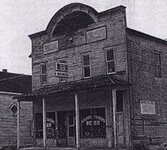Gypsy Heart
Gold Member
The old Wilson saloon is still open for business, and you can but a drink - soft, hard or inbetween - at the original mahogany bar from the Finnish barmaid or from one of one of the owners, Joyce and Clarence O'Sullivan, a general Irish couple (except she's Lithuanian) who bought the place thirty years ago and live next door.
The bar itself is high off the floor. It's what they used to call a stand-up bar. The lumberjacks and millhands would "belly-up" to the bar for their drinks. The way they figured it, bar stools were for sissies and loose women.
In these decadent times, however, there are tall bar stools for the clientele, which consists mainly of the pick-up truck trade. Business isn't rushing, but it's steady and the O'Sullivans do all right. It's better in the winter than summer, Joyce says, and better on rainy days than sunny, when there's nothing else to do.
Clarence says that the building hasn't changed a bit since it was built in 1902 by the Menominee Brewing Company, except maybe that the celing has been lowered a little. Back then, the ghost town of Wilson, on old U.S. 2 in Menominee County 17 miles west of Escanaba, was all ready thirty years old.
In 1871, the Chicage and North Western Railroad came through Spalding Township on its way from Green Bay to Escanaba, and built a depot to serve the charcoal kilns at a little settlement the railroad called Ferry Switch. Other than the charcoal kilns there wasn't much to it, but the town came back to life and started growing in 1881, when Frank D. Wilson built a big sawmill there. It got its first post office as Myra on February 24, 1881; and Daniel McIntyre, who built the first big general store, was its first postmaster. That same year, the name was changed to Wilson, and the sawmill owner replaced the storekeeper as postmaster. The first school was built in 1881.
After that, the town grew by leaps and bounds, reaching a peak of more than four hundred people around 1910. In addition to the big sawmill, which speculated in cutting railroad ties, Wilson had a shingle mill, two general stores, a hotel, blacksmith shops, two saloons, and several chesse factories. One of its most important buildings, a two-story brick mansion, was built by August Enfield, owner of one of the general stores.
Wilson continued to flourish into the 1920's. Clarence O'Sullivan says that the second floor of the Wilson saloon was a dance hall. The finest dance bands from Wisconsin made it a must-stop on the polka circuit. People from miles around came to Wilson on Saturday nights and danced into the wee hours. Even as late as 1927, Wilson had a population of over four hundred.
Then things began to slide. The sawmill closed and the chese factories went out of business. People moved away, looking for work. Fundamentally, Wilson had two strikes against it. One, it was too close to Escanaba and therefore, unnecessary; two, it was on old U.S. 2 and thus practically invisable.
The C&NW trains still pass through Wilson but they don't stop any more. The old depot, discontinued in 1950, was moved away several years ago and now serves as a storage warehouse. Along with the saloon and two to three other empty buildings, the old Enfield mansion still stands, but its windows and doors are boarded up now, and the weeds and brush flourish like a jungle around it.
Wilson still has its post office; and you can still buy a drink at the old Wilson saloon, the last and only business in town.
The bar itself is high off the floor. It's what they used to call a stand-up bar. The lumberjacks and millhands would "belly-up" to the bar for their drinks. The way they figured it, bar stools were for sissies and loose women.
In these decadent times, however, there are tall bar stools for the clientele, which consists mainly of the pick-up truck trade. Business isn't rushing, but it's steady and the O'Sullivans do all right. It's better in the winter than summer, Joyce says, and better on rainy days than sunny, when there's nothing else to do.
Clarence says that the building hasn't changed a bit since it was built in 1902 by the Menominee Brewing Company, except maybe that the celing has been lowered a little. Back then, the ghost town of Wilson, on old U.S. 2 in Menominee County 17 miles west of Escanaba, was all ready thirty years old.
In 1871, the Chicage and North Western Railroad came through Spalding Township on its way from Green Bay to Escanaba, and built a depot to serve the charcoal kilns at a little settlement the railroad called Ferry Switch. Other than the charcoal kilns there wasn't much to it, but the town came back to life and started growing in 1881, when Frank D. Wilson built a big sawmill there. It got its first post office as Myra on February 24, 1881; and Daniel McIntyre, who built the first big general store, was its first postmaster. That same year, the name was changed to Wilson, and the sawmill owner replaced the storekeeper as postmaster. The first school was built in 1881.
After that, the town grew by leaps and bounds, reaching a peak of more than four hundred people around 1910. In addition to the big sawmill, which speculated in cutting railroad ties, Wilson had a shingle mill, two general stores, a hotel, blacksmith shops, two saloons, and several chesse factories. One of its most important buildings, a two-story brick mansion, was built by August Enfield, owner of one of the general stores.
Wilson continued to flourish into the 1920's. Clarence O'Sullivan says that the second floor of the Wilson saloon was a dance hall. The finest dance bands from Wisconsin made it a must-stop on the polka circuit. People from miles around came to Wilson on Saturday nights and danced into the wee hours. Even as late as 1927, Wilson had a population of over four hundred.
Then things began to slide. The sawmill closed and the chese factories went out of business. People moved away, looking for work. Fundamentally, Wilson had two strikes against it. One, it was too close to Escanaba and therefore, unnecessary; two, it was on old U.S. 2 and thus practically invisable.
The C&NW trains still pass through Wilson but they don't stop any more. The old depot, discontinued in 1950, was moved away several years ago and now serves as a storage warehouse. Along with the saloon and two to three other empty buildings, the old Enfield mansion still stands, but its windows and doors are boarded up now, and the weeds and brush flourish like a jungle around it.
Wilson still has its post office; and you can still buy a drink at the old Wilson saloon, the last and only business in town.




